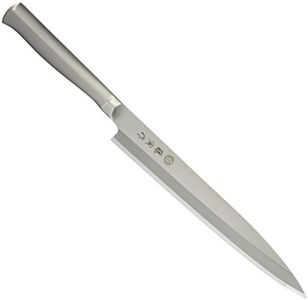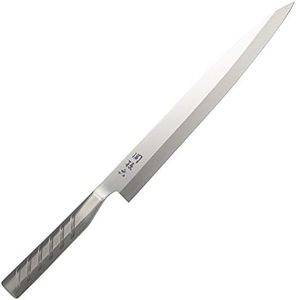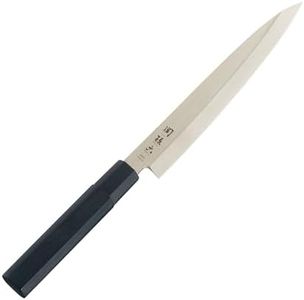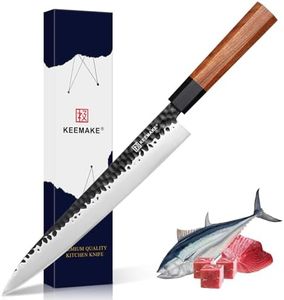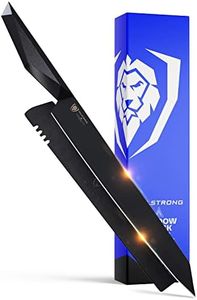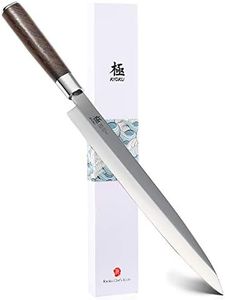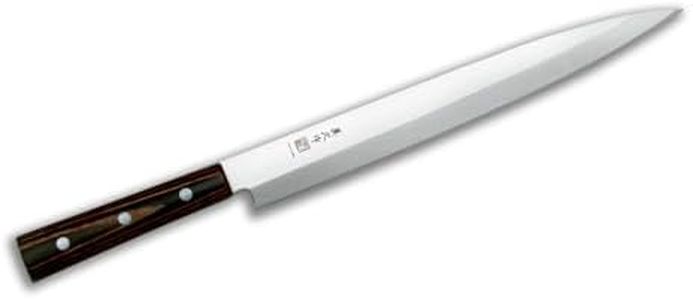We Use CookiesWe use cookies to enhance the security, performance,
functionality and for analytical and promotional activities. By continuing to browse this site you
are agreeing to our privacy policy
10 Best Sashimi Knives
From leading brands and best sellers available on the web.Buying Guide for the Best Sashimi Knives
Choosing a sashimi knife is a mindful process because this tool is designed specifically for slicing raw fish with precision. The right sashimi knife makes your cuts cleaner, helps you preserve the texture and flavor of the fish, and can enhance your overall experience in the kitchen. Your choice should balance your skill level and intended use, and understanding the main features will guide you to a knife that fits your needs.Blade LengthBlade length refers to how long the cutting edge of the knife is. In sashimi knives, a longer blade helps make single, smooth slicing motions, which is important for keeping the texture of raw fish intact. Blades typically come in lengths from about 8 to 12 inches. For beginners or those preparing smaller fish, a shorter blade (around 8 to 9 inches) gives good control. For larger cuts or frequent use, a longer blade (10 to 12 inches) provides better efficiency and can handle bigger pieces. Think about the type of fish you’ll slice most often and your comfort with handling longer blades when deciding.
Blade MaterialThe blade material affects sharpness, durability, and ease of maintenance. Common choices include stainless steel and high-carbon steel. Stainless steel is rust-resistant and easier to maintain, which is great if you want something low-fuss. High-carbon steel blades are usually sharper and hold their edge longer, but they need more care to avoid rust and staining. If you’re new or want easy maintenance, stainless steel is a safe start. However, if you’re willing to invest time in care for top performance, high-carbon steel is preferred by many professionals.
Blade ShapeBlade shape in sashimi knives is often traditional and long with a single bevel, meaning it’s sharpened only on one side. This helps create clean, precise cuts with less tearing. There are different shapes like Yanagiba, which has a slender, pointed tip for fine slicing, or Takohiki, which has a squared-off tip. Yanagiba suits most purposes and is versatile for sashimi. If you specialize in certain types of fish or seafood, the shape might matter more, but for general sashimi use, a classic Yanagiba-style shape works well.
Handle DesignThe handle design can be traditional Japanese (wa-style, round or octagonal) or Western-style (more contoured with rivets). Japanese handles tend to be lighter and allow for nimble movement, while Western handles give more weight and can feel sturdier to those used to European-style knives. The right handle for you depends on how the knife feels in your hand. Try to choose a handle that feels comfortable and secure, especially if you’ll be using it for extended periods.
Single vs Double BevelSashimi knives usually have a single-bevel edge for super-fine slicing, ideal for raw fish. Double-bevel options exist but are less traditional. Single-bevel knives require a specific cutting technique and sharpening method but give the most delicate results. If you’re dedicated to practicing skills for perfect sashimi, single-bevel is the standard choice. If you want a knife that’s easier to sharpen and can be used for broader tasks, a double-bevel might suit you.
Weight and BalanceThe weight and balance of a sashimi knife influence how comfortable and stable it feels during long slicing motions. A well-balanced, appropriately weighted knife is easier to control and reduces fatigue. Light knives make nimble movements easier, while heavier ones may give a sense of sturdiness. If possible, test a few types to find out which feels best in your hand, considering how steady and confident you feel as you cut.






